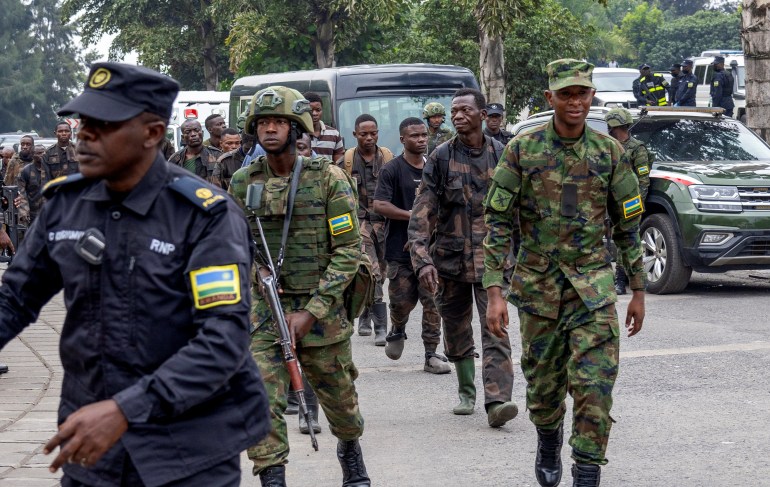Numerous bodies have been found on the streets of the eastern city of Goma, in the eastern Democratic Republic of the Congo (DRC) city of Goma, as a result of intense fighting between M23 fighters and Congolese government forces.
The rebels marched into Goma on Monday, declaring the region’s capital city under their control, a major blow to the Congolese army and a serious escalation in the region’s decades-long conflict that has resulted in the deaths of hundreds and millions of people.
Rwandan troops are stationed either on the city’s edges or across the border, according to DRC minister for rural development Muhindo Nzangi, who claimed that the Congolese army dominated Goma for the majority of the country.
At a news briefing on Tuesday, the UN and other aid organizations warned that Goma’s hospitals are overflowing with patients who are receiving gunshot, mortar, and shrapnel wounds while numerous bodies are lying in the streets.
“There are currently hundreds of people in hospital, most admitted with gunshot wounds”, said Adelheid Marschang, WHO’s emergency response coordinator for the DRC.
According to hospital sources, 367 people were treated in the city’s hospitals during the clashes, according to AFP news agency, which reported at least 17 deaths on Monday in Goma. According to a report released by Goma-based civil society organizations and non-governmental organizations, 25 people died and 375 were injured.
While “we have reports that neighbourhoods are calm, a few minutes later, we hear reports of new shelling,” said Greg Ramm, the country director for Save the Children in the DRC on Tuesday.
Heavy small arms fire and mortar fire continued in the streets, where many dead bodies could be seen, Jens Laerke, spokesperson for the UN humanitarian office, also said at a press briefing, citing reports from UN staff in the city.
The World Food Programme also expressed concern over food shortages and said that efforts to aid people in and around Goma have been “temporarily paused.”
South Africa also confirmed on Tuesday that three of its soldiers had been “caught in the crossfire” and had perished in Monday’s fighting. Additionally, it added that a third soldier who died in recent fighting also passed away on Monday, bringing the total number of fatalities in the previous week to 13.
Goma, a crucial regional hub for humanitarian assistance for displaced people, has been flooded out by the fighting, which has resulted in the evacuation of thousands of people. In addition to the three million people who were displaced in the eastern DRC last year, hundreds of thousands have fled fighting since the start of the year.
“The city is in real difficulty and if it hasn’t fallen overnight, it will in the coming days”, French Foreign Minister Jean-Noel Barrot told Sud Radio. “Rwanda must put down its weapons, calm must return and dialogue needs to restart”.

One Goma resident claimed to have seen men wearing Rwandan army garb on Monday.
“In the evening, I went out to see what the situation was. The resident of central Goma reported that I saw soldiers wearing brand-new Rwandan uniforms.
On either side of a border crossing close to Goma, Congolese and Rwandan troops engaged in firefights. On the outskirts of Gisenyi, a border town in Rwanda, 25 people died and 25 were seriously injured, according to Rwanda’s military, who spoke to AFP on Monday.
One of the hundreds of armed organizations in eastern DRC that aims to control important mineral mines is M23, or the March 23 Movement.
The group is composed of Tutsi fighters , and claims it is fighting for the rights of the DRC’s minority Tutsi population. It emerged in 2012 after a group from the armed forces of the DRC (FARDC) broke away, complaining of ill-treatment.
In 2012, M23 first seized Goma, but the Congolese army, supported by the UN forces, pushed the rebels back into the eastern hills on the border with Rwanda in 2013.
Under President Paul Kagame, the DRC government and the UN accuse Rwanda of providing soldiers and weapons to M23 in an effort to control the mineral-rich eastern DRC.
At a livestreamed event, UN peacekeeping forces’ chief Jean-Pierre Lacroix stated to reporters, “It is without question that Rwandan troops are supporting the M23.” It’s challenging to know what the numbers are exactly.
Rwanda has refuted the accusations and claimed that the Democratic Republic of the Congo (DRC) housed members of the anti-Kagame rebel group that was a part of the 1994 Rwandan genocide.
The Peace and Security Council of the African Union will hold a meeting later on Tuesday to discuss the crisis as it gets worse.
Source: Aljazeera

Leave a Reply